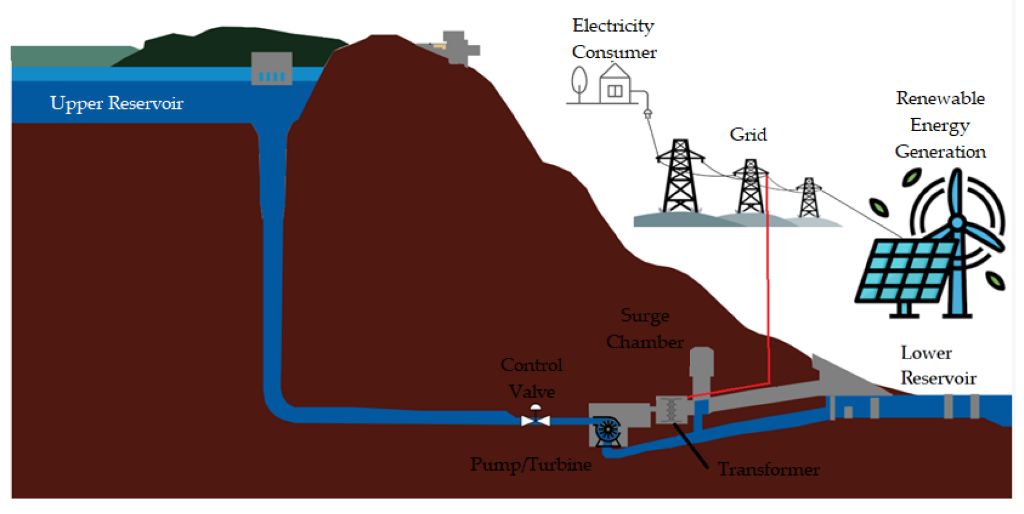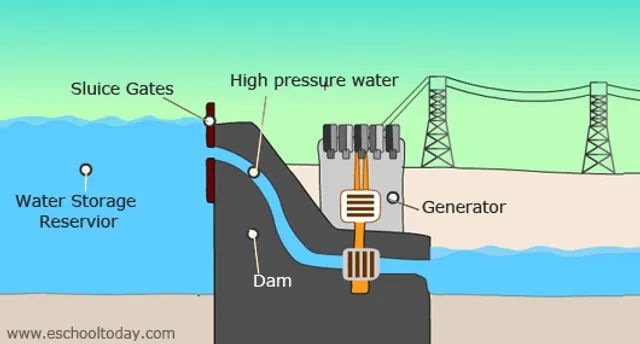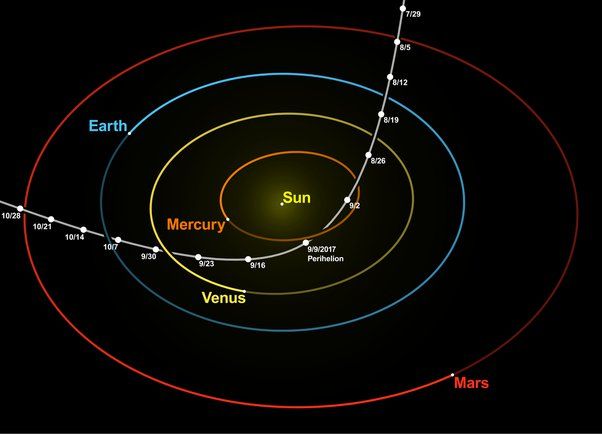Which Energy Is Stored Energy?
Energy is the ability to do work or produce heat. It exists in various forms that can be converted from one to another, such as kinetic energy, potential energy, thermal energy, electrical energy, chemical energy, nuclear energy, and more. Stored energy refers to energy that is not actively being used, but is available to do work when needed. For example, a battery stores chemical energy that can later be converted to electrical energy to power devices. Other common forms of stored energy include gravitational potential energy, like water held behind a dam, and elastic potential energy, like a compressed spring. This article will explore the different methods that energy can be stored for later use.
Potential Energy
Potential energy is stored energy that has the potential to do work. It is energy that is not actively being used but has the capacity to be transformed into kinetic energy. Potential energy can be found in several common forms:
Gravitational Potential Energy
Gravitational potential energy depends on an object’s height above the ground. The higher the object is above the ground, the greater its gravitational potential energy. For example, a book sitting on a shelf has more gravitational potential energy than when it is lying on the floor. The energy comes from the work done to lift the book against gravity.
Chemical Potential Energy
Chemical potential energy is energy stored in the bonds between atoms and molecules. Chemical reactions and nuclear reactions release this potential energy. Common examples include batteries, food, fuel, and explosives. Their chemical bonds hold energy that is released through chemical reactions.
Nuclear Potential Energy
Nuclear potential energy exists in an atom’s nucleus. It holds the energy that would be released if the nucleus split apart or fused with another nucleus. Nuclear power plants split atoms in nuclear fission to harvest this potential energy.
Elastic Potential Energy
Elastic potential energy refers to energy stored in elastic materials that are stretched or compressed. For example, a stretched rubber band or compressed spring contains elastic potential energy. This energy is released when the tension is relieved and the materials return to their original shape.
Kinetic Energy
Kinetic energy is energy associated with motion. When an object is moving, it possesses kinetic energy. The faster the object moves, the more kinetic energy it has.
Some examples of kinetic energy in everyday life include:
-
A moving car – The motion of the car represents kinetic energy.
-
Heat – On a molecular level, heat consists of the motion of atoms and molecules. The greater the molecular motion, the hotter an object is.
-
Sound – Sound waves consist of vibrating molecules that carry energy through a medium like air or water. The kinetic energy of the vibrating molecules allows sound to travel.
-
Light – Light is a form of electromagnetic radiation that can be described as a stream of photons, which are packets of energy. The motion of the photons gives light its kinetic energy.
In summary, kinetic energy exists whenever there is movement or motion. Greater speeds or vibrations correspond to higher kinetic energy.
Electrical Energy
Electrical energy is energy stored in the form of an electric charge or field. It is commonly stored in batteries and capacitors. Batteries store chemical energy and convert it into electrical energy through electrochemical reactions. The most common battery types are lead acid batteries used in vehicles and lithium-ion batteries used in consumer electronics. Capacitors store energy through the separation of positive and negative charges across two conductors. Capacitors can charge and discharge very quickly, making them useful in electronic circuits and devices requiring bursts of power.

There are many examples of electrical devices that rely on batteries or capacitors to store and provide electrical energy. These include:
- Flashlights – Use batteries to power light bulbs
- Laptop computers – Rely on lithium-ion batteries
- Smartphones – Contain rechargeable lithium-ion batteries
- Pacemakers – Have long-lasting lithium-ion batteries to provide years of steady power
- Defibrillators – Store energy in capacitors to deliver electrical shocks
- Stun guns – Use capacitors to discharge bursts of electricity
Electrical energy storage allows these devices to be portable while still packing enough power for extended operation or quick bursts when needed. Batteries and capacitors will likely continue improving and enabling more innovative electrical devices.
Chemical Energy
Chemical energy is energy stored in the bonds between atoms and molecules. When these chemical bonds are broken, usually through combustion or digestion, the stored chemical energy is released as heat and can be used to do work.
Some common examples of stored chemical energy include:
-
Food – The large molecules like fats, proteins and carbohydrates in food contain chemical energy that is released when we metabolize food.
-
Fossil fuels like coal, oil and natural gas – These fuels are rich in carbon-hydrogen and carbon-carbon bonds that release energy when combusted.
-
Batteries – Chemical reactions in batteries convert chemical energy to electrical energy that can power devices.
-
Explosives – Substances like TNT, dynamite and gunpowder contain powerful chemical bonds that release huge amounts of energy when detonated.
In summary, chemical energy represents a versatile way to store large amounts of potential energy in the bonds of molecules, which can then be released in a controlled manner to perform useful work.
Mechanical Energy
Mechanical energy is the potential energy and kinetic energy generated by the position and motion of an object. There are several ways to store mechanical energy:
Springs: Springs can be compressed or stretched to store mechanical energy. As the spring deforms, mechanical energy is stored in the elastic material. When released, the spring will convert this stored energy into kinetic energy as it returns to its original shape.
Flywheels: Flywheels store rotational kinetic energy by spinning a mass around its axis of rotation. As the flywheel spins faster, more mechanical energy is stored in the motion of the wheel. This energy can be tapped by slowing down the flywheel’s rotation.
Compressed gas: Gases can be mechanically compressed and stored under pressure in containers. The potential energy in the compressed gas can be released to drive mechanical processes. Air tanks used for scuba diving are a common example of compressed gas energy storage.
Thermal Energy
Thermal energy refers to heat or thermal energy that is stored for later use. There are several ways that thermal energy can be stored:
Hot water tanks – Hot water tanks, also known as boilers, are insulated tanks that store hot water for later use. The hot water is typically heated by natural gas, electricity, or solar panels. The thermal energy is stored in the hot water until it is needed, such as for taking a hot shower.
Molten salt – Molten salt is used to store thermal energy collected from solar power plants. The salt is heated to a high temperature where it melts and retains the thermal energy. This molten salt can then be stored and used to generate steam to power turbines when electricity is needed, even at night or on cloudy days.
Ice – Ice is used to store cooling thermal energy through a process called ice storage air conditioning. At night when electricity is cheaper, water is frozen into ice. During the day the ice is melted to provide cooling for air conditioning. This allows shifting the electrical load to off-peak times.
Nuclear Energy
Nuclear energy is stored in the nucleus of atoms. It comes from the binding energy that holds protons and neutrons together in the atomic nucleus. The binding energy is released when the nuclei are combined or split apart in nuclear reactions. Uranium and thorium contain fissile isotopes that can undergo nuclear fission to produce large amounts of energy. Nuclear fuel like enriched uranium contains concentrated nuclear binding energy that can be used to generate electricity.
Nuclear power plants use nuclear fission of uranium or plutonium to heat water into steam that spins turbines to generate electricity. The nuclear binding energy provides an extremely concentrated source of power from a small amount of fuel. Nuclear reactions also occur in weapons like atomic bombs that release enormous amounts of nuclear energy at once.
On a smaller scale, radioisotopes with unstable nuclei are used for applications like medical imaging and cancer treatment. As the nuclei decay, they release ionizing radiation that can be detected and targeted to diseased tissue and tumors. Nuclear medicine utilizes the nuclear binding energy stored in radioactive isotopes.
Nuclear fusion is another nuclear process that combines light nuclei into heavier ones, releasing high amounts of energy. Fusion powers stars like the sun, but has not yet been successfully harnessed for electricity generation. Nuclear energy from fission and fusion has the potential to provide vast amounts of power with minimal fuel input.
Comparison of Storage Methods
When comparing different energy storage methods, there are several key factors to consider:
Storage Capacity
Some storage methods like batteries and flywheels have relatively small storage capacities, while methods like pumped hydroelectric power plants can store very large amounts of energy.
Discharge Time
Certain technologies like capacitors discharge very quickly, while thermal stores may discharge over longer periods of time. This makes capacitors suitable for smoothing out short power fluctuations, while thermal storage works better for long-term needs.
Efficiency
The round-trip efficiency of storage methods can vary widely. For example, lithium-ion batteries may be 90-95% efficient, while compressed air energy storage might be only around 50% efficient from charge to discharge.
Power Rating
Some storage technologies are better at delivering high power output quickly (like flywheels and capacitors), while others are optimized for energy storage capacity rather than power discharge rate.
Cost
The levelized cost of storage takes into account capital costs, operating costs, and cycle life. Pumped hydro storage tends to be low cost, while batteries and compressed air storage have higher costs.
Maturity
Mature technologies like pumped hydro and lead-acid batteries are well-understood, while newer technologies like flow batteries require further development and testing to reach full commercial viability.
By weighing factors like these, it’s possible to select the best energy storage options for specific applications and grid needs.
Conclusion
In this article, we explored the different types of stored energy. The main forms of stored energy include potential energy, kinetic energy, electrical energy, chemical energy, mechanical energy, thermal energy, and nuclear energy.
Stored energy is crucial for our modern way of life. It allows us to harness energy when we need it, not just when it is naturally available. For example, chemical energy stored in batteries provides electricity on demand to power our devices and homes. Potential energy stored in dams provides hydroelectric power that can be dispatched to meet peak energy demands.
Developing effective and efficient methods of energy storage is an important challenge as we transition to more renewable energy sources like solar and wind power. These sources produce energy intermittently based on weather conditions. With improved storage solutions, excess renewable energy can be captured and used at times of high demand.
In summary, stored energy gives us flexibility in how and when we use energy. Finding new and better ways to store energy will be key for building a sustainable energy future.




